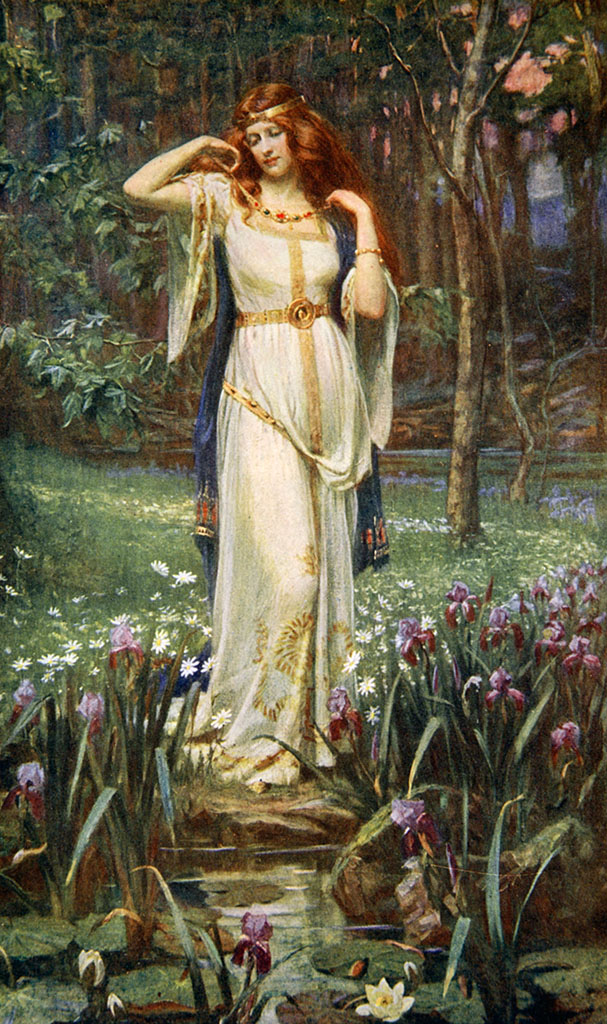Seidr is a form of Norse magic that involves foretelling and shaping the future. Referred to in Old Norse as seiðr, this type of magic was an important part of the Norse religion in ancient Scandinavia. Women practitioners, sometimes called seiðkona, would travel from town to town, performing seidr rituals.
Seidr practitioners were usually women called volva (völva). The word volva means “seeress” in Old Norse. Some women took the title spákona (prophetess) instead because of the negative connotations of the practice of seidr.
Seidr rituals and other facets of Norse paganism remained a large part of the Nordic culture for centuries. But the spread of Christianity would soon end the ancient magical practice.
As Christianity gained a foothold in Iceland, Norway, Sweden, and neighboring countries, seidr was increasingly devalued.
What can seidr do?
Seidr (seiðr) is a type of shamanic magic that includes prophecies, divination, channeling the gods and goddesses, and performing spells that influence weather.
Seidr also has the power to influence animals. A woman practicing seidr could shapeshift or cast her spirit into an animal to manipulate them. Any animal, including sea animals like whales and seals, could be controlled by the power of seidr.
Eiriks saga Rauda (Erik the Red) describes seidr as a type of seance where spirits are summoned through rituals and magical artifacts.
In the Ynglinga Saga by Snorri Sturluson, seidr practitioners use manipulative magic and divination to see and alter the future. Influenced by his own religious beliefs, Snorri Sturluson suggested that practicing seidr made a person weak.
Can men practice seidr?
Even though seidr is often considered “women’s magic,” men also practice it.
Male seidr practitioners were known as seiðmenn (seidmenn). While a man could technically practice seidr, seiðmenn were insulted as unmanly or ergi.
Even the god Odin (Óðinn) was taunted by Loki for being a seiðmenn. In the poem Lokasenna from the Poetic Edda, we learn that Loki regularly accused Odin of being a seidr practitioner.
In the Viking age of tough warriors who lived to die an honorable death in battle, being called unmanly was a severe offense. Men who practiced seidr were labeled argr (the adjective version of ergi) and teased mercilessly.
Still, male seidr workers continued the practice of seidr even though they were socially ostracized for it.
Did Æsir and Vanir deities practice Norse Magic?
The Norse gods were known to practice seidr.
In Norse mythology, the goddess Freyja and Odin were most closely associated with the practice of seidr.
In the Poetic Edda’s poem Völuspá, we learn that the three norns were also seidr practitioners. These giantesses lived in Asgard and tended to the world tree Yggdrasil. Their names are Urðr (what has happened), Verðandi (what is happening), and Skuld (what will happen).
Together they weave the Web of Wyrd, which binds all beings to their fate. This thread was spun through a tool called a distaff, which created the “threads of fate.” Like the Fates of Greek mythology, the norns spun, measured, and cut the strings of all living beings. Even Odin himself was subject to the prophecies of the norns.

Norse magic in the Viking age
Seidr wasn’t the only form of magic practiced in the Viking age. Galdr, runic magic, and spá were all part of Norse magic. Spá is closely related to seidr, while galdr and runic magic are unique magical practices.
Spá is the magic of foreseeing or uncovering something through intuition. Throughout the centuries, the differences between seidr and spa have blurred, so their original meanings have been lost. Today, the two practices are sometimes distinguished by how the prophecy is reached. Spá is an intrinsic part of a woman’s natural self or the feminine divine. Seidr practitioners use witchcraft to find answers and sometimes alter the future.
Galdr uses incantations typically sung by men. These incantations were used for all sorts of situations. The most common example of galdr used by women was an incantation to ease the pain of childbirth. A master of galdr is believed to have the power to sink ships, create storms, and even render weapons useless in battle.
Runic magic is an integral part of Norse religion. Odin’s spear was said to be carved with runes that ensured the spear never missed its mark, no matter how far away. Runes hold so much power in Norse mythology that Odin was willing to suffer greatly to learn their secrets. Odin hanged himself from Yggdrasil for 9 days and nights just to learn how to read the runes carved in Yggdrasil’s trunk.
Though Norse mythology is filled with references to runes and their power, how to use them is never specifically mentioned. The meaning of many of the runes carved into artifacts remains a mystery to this day.

